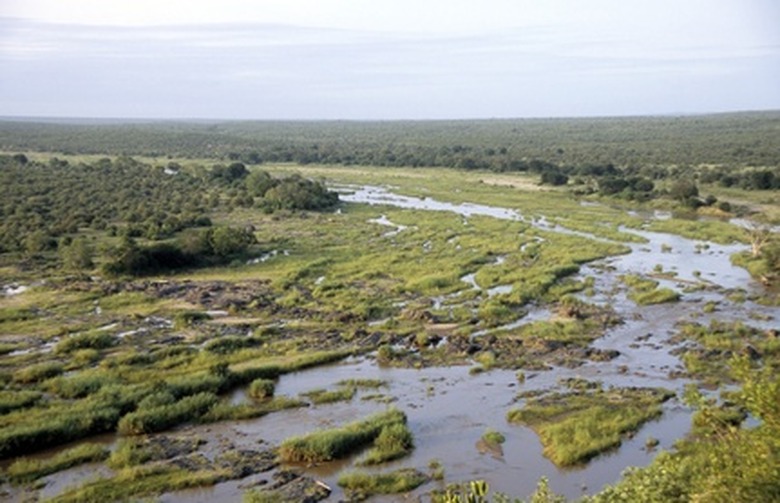How Do Wetlands Purify Water?
Pictures of wetlands sometimes depict boggy, grassy areas lacking life and diversity. The truth is that wetlands are full of diverse life and play an important role in our ecosystems. They offer habitat for plants, insects, migrating birds, large mammals such as moose, smaller mammals such as beavers or minks, reptiles and amphibians.
Depending on where you are from, you may have heard of wetlands called bogs, marshes, swamps or fens.
Value of Wetlands
Value of Wetlands
Why should we protect wetlands? Wetlands with high biodiversity help purify water and provide habitat for fish, reptiles, birds and small aquatic invertebrates. They also act as a buffer for excess rain in our environment. When an area gets a lot of rain, the wetlands soak up excess water like a sponge.
When it's dry, wetlands slowly release the water that was stored. Wetlands help slow the process of erosion by trapping sediments.
Wetlands as Water Treatment
Wetlands as Water Treatment
As sediment, excess nutrients and chemicals flow off of the land, wetlands filter the run off before it reaches open water. Nutrients are stored and absorbed by plants or microorganisms. Sediment settles at the bottom after reaching an area with slow water flow.
Additionally, carbon and greenhouse gases are stored in sinks in wetlands instead of being released into the atmosphere. This natural purification definition is an example of the value of wetlands in our environments.
Changing Water Flows
Changing Water Flows
The water regime is how rivers and wetlands change in response to rainfall and groundwater flow. It includes how much water is present, as well as its duration and location it is located. There are many ways that a water regime can be affected, particularly by humans. These include damming rivers, pumping water and constructing farm dams or banks that change drainage patterns.
Impact of Wetland Loss
Impact of Wetland Loss
There are numerous threats to wetlands. Water extraction, climate change, invasive plants, uncontrolled fires and poor agricultural practices all can cause the loss of wetland habitat. Without wetlands, our environments would look drastically different.
Wetlands and the vegetation in them prevent erosion. Without wetlands, there would be increased sediment in bodies of water that would prevent light from reaching aquatic plants. Higher levels of sediment could also cause aquatic habitats to be unsuitable for aquatic animals.
Without wetlands, large amounts of nutrients would be released into streams and lakes instead of filtered out. The excessive nutrients would cause plants and algae to grow at an increased rate, potentially creating algal blooms that block out light and use up all of the oxygen in an area of water. Salts would move closer to the surface and slow plant growth, and acids and metals may be released into the soil, and later water, if wetlands weren't around to filter it first.
Resilience to Natural Hazards
Resilience to Natural Hazards
In addition to saving water for periods of drought and absorbing excess water in times of flooding, wetlands are able to offer environmental resilience to a number of other natural hazards. They can be a natural barrier to fires and help reduce frequency of fire events. Marshes along coastlines can also reduce wave height and wind speeds before they reach the shoreline, lessening overall storm damage.
Improving Wetland Management
Improving Wetland Management
It is important to continue conservation of wetlands. Rehabilitation and restoration of wetlands are excellent opportunities for improvement, as well as monitoring different environments to determine if a wetland's quality is improving or declining over time. There are other practices, such as catching nutrients and salts from agriculture before they reach water bodies, that would help water quality improve. The value of wetlands in our environments is not to be underestimated.
References
- International Institute for Sustainable Development: Nature's Wealth
- Australian Dept. of the Environment and Energy: Wetlands and Water Quality
- Australian Dept. of the Environment and Energy: Wetlands and Changes in Water Flows
- Australian Dept. of the Environment and Energy: Wetlands and Resilience to Natural Hazards
Cite This Article
MLA
Taylor, Lindsey. "How Do Wetlands Purify Water?" sciencing.com, https://www.sciencing.com/do-wetlands-purify-water-7585568/. 22 November 2019.
APA
Taylor, Lindsey. (2019, November 22). How Do Wetlands Purify Water?. sciencing.com. Retrieved from https://www.sciencing.com/do-wetlands-purify-water-7585568/
Chicago
Taylor, Lindsey. How Do Wetlands Purify Water? last modified March 24, 2022. https://www.sciencing.com/do-wetlands-purify-water-7585568/
